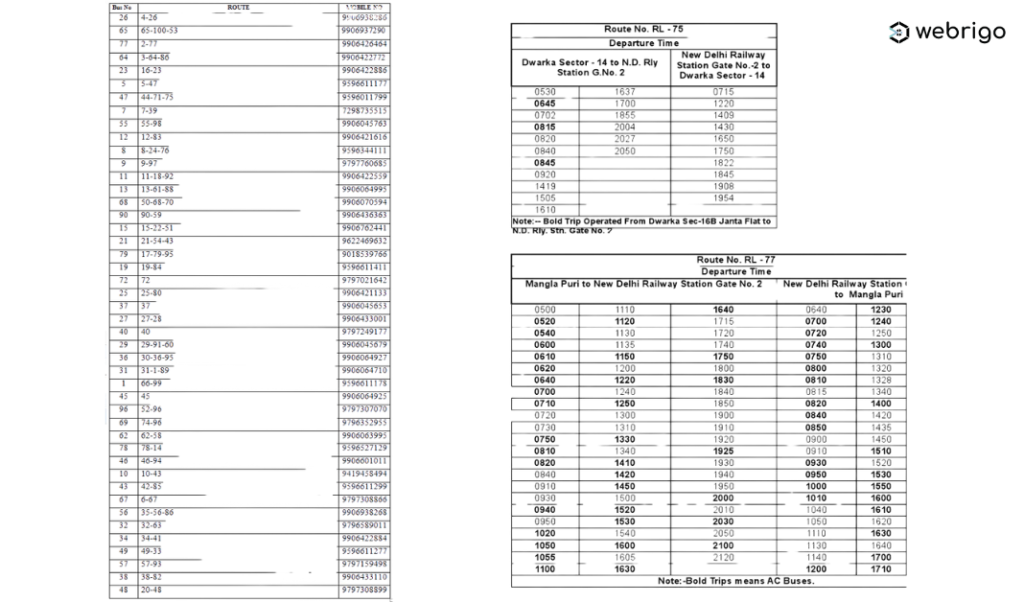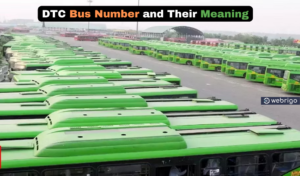The Delhi Transport Corporation (DTC) manages one of the world’s largest bus networks, and its bus numbers play a key role in guiding passengers. These numbers aren’t random; they provide valuable details about the route, including where it starts, ends, and the areas it covers. By understanding the meaning behind DTC bus numbers, you can save time and avoid confusion during your travels. This blog explains the DTC bus numbering system in simple terms, making it easier for you to plan your journey and explore Delhi’s extensive bus network without any hassle.
What is the DTC Bus Number System?
The DTC bus number is a unique identifier assigned to each route operated by the Delhi Transport Corporation. These numbers are not random; they provide essential information about the route, its origin, destination, and sometimes the areas it covers.
How the DTC Bus Numbering System Works
The DTC bus numbering system is logical and based on specific categories. There are multiple aspects that you need to understand.
Type of Bus Service:
DTC buses can be broadly categorized into the following services:
- Ordinary Buses: Regular buses that stop at all designated stops along the route. These are generally numbered without prefixes.
- Cluster Buses: Operated under the Delhi Integrated Multi-Modal Transit System (DIMTS), these buses have the prefix “GL” followed by a number (e.g., GL-23).
- AC Buses: Air-conditioned buses may have unique route numbers or share routes with ordinary buses but operate with a different service type.
- Night Buses: These buses are marked for late-night services and may have distinct numbers or identifiers.
Route Information:
The numbers provide information about the geographical coverage:
Single-Digit and Double-Digit Numbers: These routes typically cover shorter distances or specific areas within the city.

Understanding DTC Bus Numbers and What They Mean
The Delhi Transport Corporation (DTC) manages one of the world’s largest bus networks, and its bus numbers play a key role in guiding passengers. These numbers aren’t random, they provide valuable details about the route, including where it starts, ends, and the areas it covers.
By understanding the meaning behind DTC bus numbers, you can save time and avoid confusion during your travels. This blog explains the DTC bus numbering system in simple terms, making it easier for you to plan your journey and explore Delhi’s extensive bus network without any hassle.
What is the DTC Bus Number System?
The DTC bus number is a unique identifier assigned to each route operated by the Delhi Transport Corporation. These numbers are not random; they provide essential information about the route, its origin, destination, and sometimes the areas it covers.
How the DTC Bus Numbering System Works
The DTC bus numbering system is logical and based on specific categories. There are multiple aspects that you need to understand.
Type of Bus Service:
DTC buses can be broadly categorized into the following services:
- Ordinary Buses: Regular buses that stop at all designated stops along the route. These are generally numbered without prefixes.
- Cluster Buses: Operated under the Delhi Integrated Multi-Modal Transit System (DIMTS), these buses have the prefix “GL” followed by a number (e.g., GL-23).
- AC Buses: Air-conditioned buses may have unique route numbers or share routes with ordinary buses but operate with a different service type.
- Night Buses: These buses are marked for late-night services and may have distinct numbers or identifiers.
Route Information:
The numbers provide information about the geographical coverage:
- Single-Digit and Double-Digit Numbers: These routes typically cover shorter distances or specific areas within the city, for example, Bus 1 runs between Mori Gate and Jahangirpuri.
- Three-Digit Numbers: Indicate longer or more complex routes that may traverse multiple zones in Delhi. For instance, Bus 347 connects Karol Bagh to Badarpur.
Prefix and Suffix:
- Prefix Letters: Some buses have prefixes like “GL” or “TMS,” which indicate cluster buses or other special services.
- Suffix Letters: Buses may have a letter attached to their route number, like 410A or 534B. These usually signify slight route variations, such as a different endpoint or additional stops.
How to Find the Nearest Bus Stop in Delhi
Examples of Common DTC Bus Routes and Numbers:
To better understand the DTC bus number meaning, let’s explore a few common examples:
- Bus 781: This bus operates between Nehru Place and Uttam Nagar Terminal. The three-digit number indicates a long route covering significant areas of South and West Delhi.
- Bus 400: Connects Old Delhi Railway Station to Badarpur and covers critical points in Central and South Delhi.
- GL-22: A cluster bus route connecting Delhi University’s North Campus to Vasant Vihar.
Decoding Special Services:
DTC also runs special services for specific purposes, which have unique identifiers:
- Airport Express Buses: These routes are specifically designed to connect significant parts of Delhi to the Indira Gandhi International Airport. An example is Bus 711A, which operates from Kashmere Gate to IGI Airport.
- Festival and Tourist Buses: During major festivals or for tourist purposes, DTC runs temporary bus services with clear route descriptions on the buses.
- Ladies’ Special: Some routes cater exclusively to women during peak hours, ensuring safer travel options.
Why Understanding DTC Bus Numbers Matters:
Knowing the DTC bus number meaning can:
- Save you time by identifying the right bus quickly.
- Help you plan your journey efficiently by understanding routes and stops.
- Reduce confusion for first-time or occasional commuters in Delhi.
- It allows you to use apps or maps more effectively when searching for the right bus.
Tips for Using DTC Bus Services:
To make the most of your commute using DTC buses, keep these tips in mind:
- Use Online Tools: Apps like Delhi Transit or Google Maps can help you find the best routes and check the live status of buses.
- Check the Destination Board: Always verify the destination displayed on the bus’s electronic or manual boards.
- Ask the Conductor: If in doubt, don’t hesitate to confirm with the bus conductor or driver.
- Stay Informed About Updates: DTC occasionally revises its routes, so stay updated with changes through its official website or notifications.
Conclusion on DTC Bus Number and its Meaning:
Understanding the meaning of the Delhi bus number is crucial for a hassle-free travel experience in the city. The DTC bus numbering system is designed to simplify navigation and provide essential route details to commuters.
Whether you’re a daily traveler or a first-time visitor, decoding the DTC bus number can significantly enhance your experience of commuting in Delhi.

